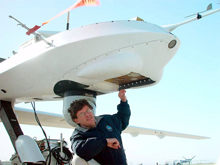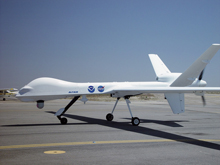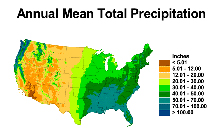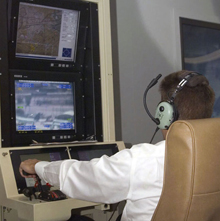The Future of Climate Research
NOAA conducts a wide range of sustained observations and research to understand complex climate systems and how they work. This research advances climate projections and provides information to enhance society's ability to plan and respond to climate variation in both the shorter term, like cold spells or periods of drought, and over longer periods such as decades, centuries and beyond.
U.S. industries that are sensitive to weather and climate account for one third of the nation's Gross Domestic Product, making the ability to project changes in climate vitally important in social and economic planning.
Imagine a future where we understand and predict climate trends and variability with a reasonable amount of certainty. Armed with this knowledge, we can make informed decisions that reduce the socioeconomic impact of weather events on the ever-increasing global population and help us live in harmony with the delicate checks and balances of nature.
NOAA scientists continually work to understand and describe climate variability and change in order to enhance society's capacity to anticipate and respond to climate change. Advancing our knowledge of the processes that drive the natural environment requires a continually evolving process of discovery, observation, and analysis.

A NOAA researcher conducts preflight tests before flying the Altair unmanned aircraft system. Click image for larger view and full caption.
As NOAA plans for the future, long-term climate efforts will focus on developing a predictive understanding of variability and change in the global climate system and application of this information in sectors of the economy which are most affected by weather and climate. This article looks at the range of basic and applied research, observations and modeling, and assessment activities that will dominate NOAA climate research in the next two decades.
Climate Science: Where We've Been
Climate science has been revolutionized in the past decade and NOAA has played a significant role in planning and sponsoring the world’s most extensive program of scientific observation, research, and assessment for climate change and variability. NOAA has supported research and technology to globally monitor and analyze important aspects of global climate, such as the effects of El Nino and the impacts of drought on regional/local climate. Scientists have developed decadal-scale global observations which allow assessment of climate trends and for improved initialization of global climate models. Significant improvements in the performance of climate models have allowed NOAA to better project future changes of the Earth’s climate system.

A meteorologist at the console of the IBM 7090 electronic computer in the Joint Numerical Weather Prediction Unit. This computer was used to process weather data for short- and long-range forecasts, analyses, and research. Click image for larger view.
While NOAA uses its global climate models to project climate change, uncertainties remain large because of insufficient knowledge about components of the Earth’s climate system and the interactions among them. Some biological, geological, and chemical processes in the climate system, long known to be major factors in climate change, remain poorly understood and poorly modeled.
NOAA scientists made key contributions to understanding the cause of the depletion of the stratospheric ozone layer. However, research is still needed to predict the course of ozone depletion in the context of a changing future climate.
Where We Are Going
Operational and research activities in NOAA's climate program cover a large range of temporal and spatial scales. NOAA develops climate products to support a range of international, national, regional, and local users. In the next 20 years, fundamental, long-term research on a broad range of global change issues will remain a high priority for NOAA.
Specifically, NOAA's climate research objectives are to:
- describe and understand the state of the climate system through integrated observations, analysis, and modeling;
- reduce uncertainty in our understanding of atmospheric composition and feedbacks that contribute to changes in Earth's climate;
- provide climate forecasts for multiple time-scales, to enable regional and national managers to better plan for the impacts of climate;
- provide climate assessments and projections to support policy decisions with objective and accurate climate change information;
- understand and predict the consequences of climate variability and change on marine ecosystems; and
- provide information and tools to support decision makers in improving management of risks to the U.S. economy in sectors and areas that are sensitive to impacts from weather and climate.
Increased Integration

Altair is a high altitude, long endurance unmanned aerial system built initially to support NASA's Earth science research needs. Click image for larger view and full caption.
Integration of research across existing disciplines is a central theme of NOAA's future climate research. The links among the land, ocean, polar ice, atmosphere, and biosphere must be further explored, bolstering our nascent understanding of the complex interrelationships that comprise the global climate system.
Technological Advances
As we move into the future, technology will play a larger role in advancing understanding of climate. A glimpse into the global observation system of the future might reveal:
- A global unmanned aircraft system, stationed in fixed locations around the Earth’s lower stratosphere over oceans and polar regions, which would routinely drop probes and descend at locations near the Earth’s surface. These probes would provide detailed profiles of clouds and measure aerosols and cloud chemistry.
- Networks of data buoys distributed over the oceans that would provide a wide range of surface and sub-surface ocean data, such as sea surface temperatures and waves. In addition to providing data for climate assessments, information from these buoys would serve as early detectors of tsunamis.
- A space-based Doppler Wind LIDAR (Light Detection and Ranging) sensor aboard a polar-orbiting satellite that would provide vertical profiles of winds at hundreds of points. These data could, for example, bring further improvement to hurricane track forecasting.
Integrating these technologies into the Global Earth Observation System of Systems will bring improvements in the density and coverage of environmental observations and will create a strong base for improvements in environmental prediction.
Meeting Societal Needs
NOAA efforts in the future will also focus on making societal connections. For example, NOAA's Climate Variability and Human Health Program applies a problem-oriented approach to the use of climate and environmental information for public benefit. By fostering greater coordination among federal, state, academic, and private sector partners, NOAA aims to provide scientifically sound, socially relevant, and technically useable climate and environmental information for the public health community.

Maps such as this one prepared by NOAA showing annual precipitation are used by a wide range of sectors. Click image for larger view.
NOAA will be positioned to support society's changing needs for climate information and services over the next 20 years and beyond. Meeting these needs will enable society to make the best social and economic decisions. The economic significance of longer-term climate predictions for activities such as agriculture, manufacturing, and recreation will grow substantially. NOAA will be involved in a range of activities to support changing needs.
NOAA will make seasonal to decadal climate predictions with clearly stated levels of uncertainty. This will be enabled by increased observation data; improved understanding and modeling of the Earth system; advances in the speed, accessibility, and reduced cost of information technology; and the pervasiveness and reduced cost of telecommunications technology.

Unmanned aircraft systems are powered aerial systems that do not carry a pilot, but are independently or remotely piloted. Here, a pilot navigates the Altair unmanned aircraft system at a console. Click image for larger view.
Climate-related products will move increasingly towards outlooks on regional scales, accompanied by well-described uncertainties. NOAA will conduct and sponsor research to improve our understanding of key physical processes, such as how land surface changes impact drought. The ultimate goal of these activities is to mitigate the socioeconomic impacts of climate hazards. This goal can only be achieved by improving the predictability limits of climate and also providing assessment/prediction products designed for specific external community needs.
Probabilistic statements about climate outcomes will become standard and will be formulated to improve their utility for decision makers and the public. Improved seasonal forecasts will allow resource managers to better mitigate agricultural and other impacts from extreme weather events or abrupt climate change, to practice better resource management, and to combat the spread of temperature-sensitive diseases.
Some specific NOAA climate-related products and services in the future may include:
- improved intra-seasonal through decadal forecasts using Earth system models;
- water resource and drought forecasts, including information about nutrient runoff;
- weather-related disease forecasts (e.g., malaria, SARS, West-Nile virus);
- projections of sea level change;
- decadal predictions of seasonal hurricane activity;
- scenarios for future climate mitigation and adaptation– including land use changes; and
- decision-support climate information and assessments.
Conclusion
Research is the cornerstone on which to build and improve environmental forecasts that can enable ecosystem-based management and provide critical weather and climate information for decisions makers and the public. Oceanic and atmospheric sciences are poised for progress in quantum leaps. NOAA is leading the way in delivering the information and services that the nation will need to make intelligent decisions about our environmental resources in the future.
